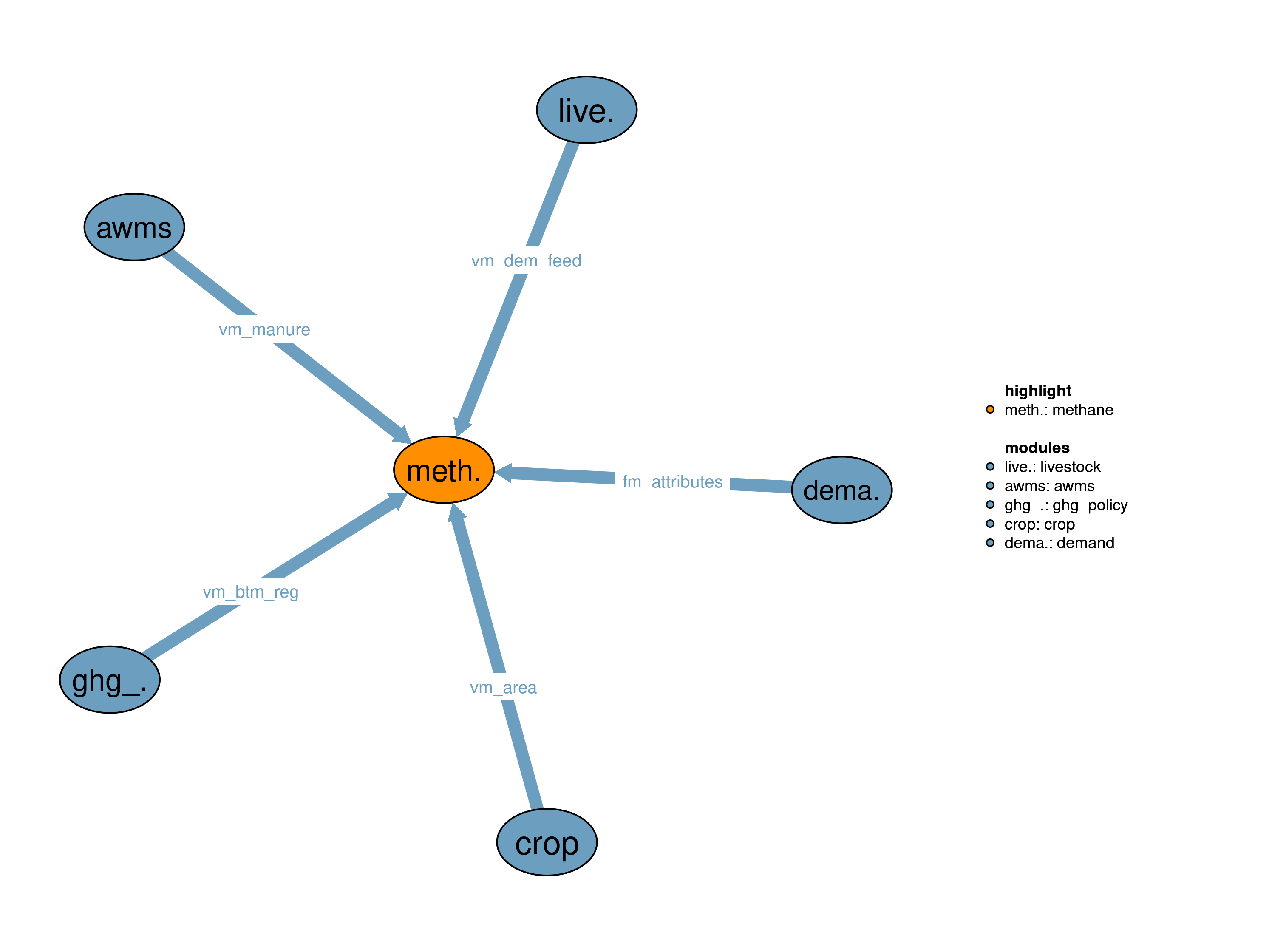This module calculates methane emissions according to 2006 IPCC Guidelines of National Greenhouse Gas Inventories. See also IPCC (2006).

| Description | Unit | A | B | |
|---|---|---|---|---|
| fm_attributes (attributes, kall) |
Conversion factors - where X is ton N P K C DM WM or PJ GE | \(X/tDM\) | x | |
| vm_area (j, kcr, w) |
Agricultural production area | \(10^6 ha\) | x | |
| vm_btm_reg (i, emis_source, pollutants) |
Regional emissions before technical mitigation | \(Tg/yr\) | x | x |
| vm_dem_feed (i, kap, kall) |
Regional feed demand including byproducts | \(10^6 tDM/yr\) | x | |
| vm_manure (i, kli, awms, npk) |
Calculation of manure excreted in confinements | \(10^6 t X\) | x |
This module realization calculates methane from different agricultural sources based on the IPCC (2006). Methane emission sources considered in the module are enteric fermentation, animal waste management, and rice.
We calculate methane emissions before technical mitigation(btm) in each regions (reg) (vm_btm_reg) from the aforementioned three sources of emissions step-by-step in the following three equations.
The first equation describes how CH4 emission from enteric fermentation is calculated. The equation shows that total methane from enteric fermentation depends on the animal feed demand type (vm_dem_feed) and the purpose of raising livestock - either for meat (livst_rum) and/or milk (livst_milk). The factor 1/55.65 t/GJ in the equation is the energy content of methane. The other scalars - 0.065 and 0.03 - refer to the share of gross energy (ge) in feed released as methane for dairy cattle and ruminants respectively.
\[\begin{multline*} vm\_btm\_reg(i2,"ent\_ferm","ch4") = \frac{ 1}{55.65 } \cdot \left(\sum_{k\_conc53}\left( vm\_dem\_feed(i2,"livst\_rum",k\_conc53) \cdot fm\_attributes("ge",k\_conc53) \cdot 0.03\right) + \sum_{k\_conc53}\left( vm\_dem\_feed(i2,"livst\_milk",k\_conc53) \cdot fm\_attributes("ge",k\_conc53) \cdot 0.065\right) + \sum_{k\_noconc53,k\_ruminants53}\left(vm\_dem\_feed(i2,k\_ruminants53,k\_noconc53) \cdot fm\_attributes("ge",k\_noconc53) \cdot 0.065\right)\right) \end{multline*}\]
As such, methane from enteric fermentation depends on the feed quality and the purpose of livestock farming. The feed quality (measured by energy content of the feed type) can be k_conc53 ( with high energy contents, for example, temperate and tropical cereals, maize,pulses) or k_noconc53 (for example, pasture, fodder,crop residues). The purpose of livestock raising k_ruminants53 can be either for meat (livst_rum) or for milk (livst_milk). The parameter fm_attributes in MAgPIE captures a content of some thing (e.g. gross energy-ge, dry matter-dm, reactive nitrogen-nr) in a given commodity. These attributes or coefficients are then used in content conversions in may modules of the model.
The second equation of this realization is meant to calculate CH4 emission from animal waste management (AWM). In general, AWM depends on the amount of manure excreted in confinements (such as stables or barns) (see 55_awms)and its subsequent storage. We calculate the CH4 emission per unit of nitrogen in manure based on IPCC (2006) and Manure Management Emissions from FAOSTAT (2016) . See the module for more on calculation of methane from animal waste(or manure) .
\[\begin{multline*} vm\_btm\_reg(i2,"awms","ch4") = \sum_{kli}\left( vm\_manure\left(i2, kli, "confinement", "nr"\right) \cdot \sum_{ct} f53\_ef\_ch4\_awms(ct,i2,kli)\right) \end{multline*}\]
The third equation of this realization calculates methane emissions from rice cultivation. As presented below CH4 from rice is a function of harvested area of rice and th CH4 emission intensity of rice (measured as CH4 per hectare of rice). The calculation is based on IPCC (2006) and Rice Cultivation Emissions from FAOSTAT (2016).
\[\begin{multline*} vm\_btm\_reg(i2,"rice","ch4") = \sum_{cell(i2,j2),w}\left( vm\_area(j2,"rice\_pro",w) \cdot \sum_{ct}f53\_ef\_ch4\_rice(ct,i2)\right) \end{multline*}\]
Limitations CH4 emissions from animal waste management may be inconsistent with CH4 emissions from enteric fermentation.
This realization is simple and accounts no methane emissions. We acknowledge this is unrealistic. It is presented here for mere comparison and completeness.
Methane emission from agricultural sources equals to zero.
vm_btm_reg.fx(i,emis_source,"ch4") = 0;Limitations It is unrealistic to consider zero methane emissions and to ignore it from a model such as MAgPIE which is meant to assess impacts of agricultural production on environment.
| Description | Unit | A | B | |
|---|---|---|---|---|
| f53_ef_ch4_awms (t_all, i, kli) |
CH4 emission per livestock products | \(CH4/tDM\) | x | |
| f53_ef_ch4_rice (t_all, i) |
CH4 emission per ha rice | \(CH4/ha\) | x | |
| q53_emissionbal_ch4_awms (i) |
Detailed ch4 constraint for animal waste management systems before technical mitigation | \(tCH4\) | x | |
| q53_emissionbal_ch4_ent_ferm (i) |
Detailed ch4 constraint for enteric fermentation before technical mitigation | \(tCH4\) | x | |
| q53_emissionbal_ch4_rice (i) |
Detailed ch4 constraint for rice before technical mitigation | \(tCH4\) | x |
| description | |
|---|---|
| attributes | Product attributes characterizing a product (such as weight or energy content) |
| awms | animal waste management systems |
| cell(i, j) | Mapping between regions i and clusters j |
| ct(t) | Current time period |
| emis_source | Emission sources |
| emis_source_nomethane53(emis_source) | emission sources |
| i | World regions |
| i2(i) | World regions (dynamic set) |
| j | Spatial clusters |
| j2(j) | Spatial Clusters (dynamic set) |
| k_conc53(kall) | feedstuff with high energy content |
| k_noconc53(kall) | non-concentrates |
| k_ruminants53(kli) | ruminant subset |
| kall | All products in the sectoral version |
| kap(k) | Animal products |
| kcr(kve) | Cropping activities |
| kli(kap) | Livestock products |
| npk(nutrients) | Plant nutrients |
| pollutants(pollutants_all) | subset of pollutants_all that can be taxed |
| t_all | 5-year time periods |
| t(t_all) | Simulated time periods |
| type | GAMS variable attribute used for the output |
| w | Water supply type |
Benjamin Leon Bodirsky
16_demand, 30_crop, 55_awms, 56_ghg_policy, 70_livestock
FAOSTAT. 2016. “FAOSTAT Database.” Rome: The Food; Agriculture Organization of the United Nations (FAO). http://www.fao.org/faostat/en/.
IPCC. 2006. “2006 IPCC Guidelines for National Greenhouse Gas Inventories, Prepared by the National Greenhouse Gas Inventories Programme.”